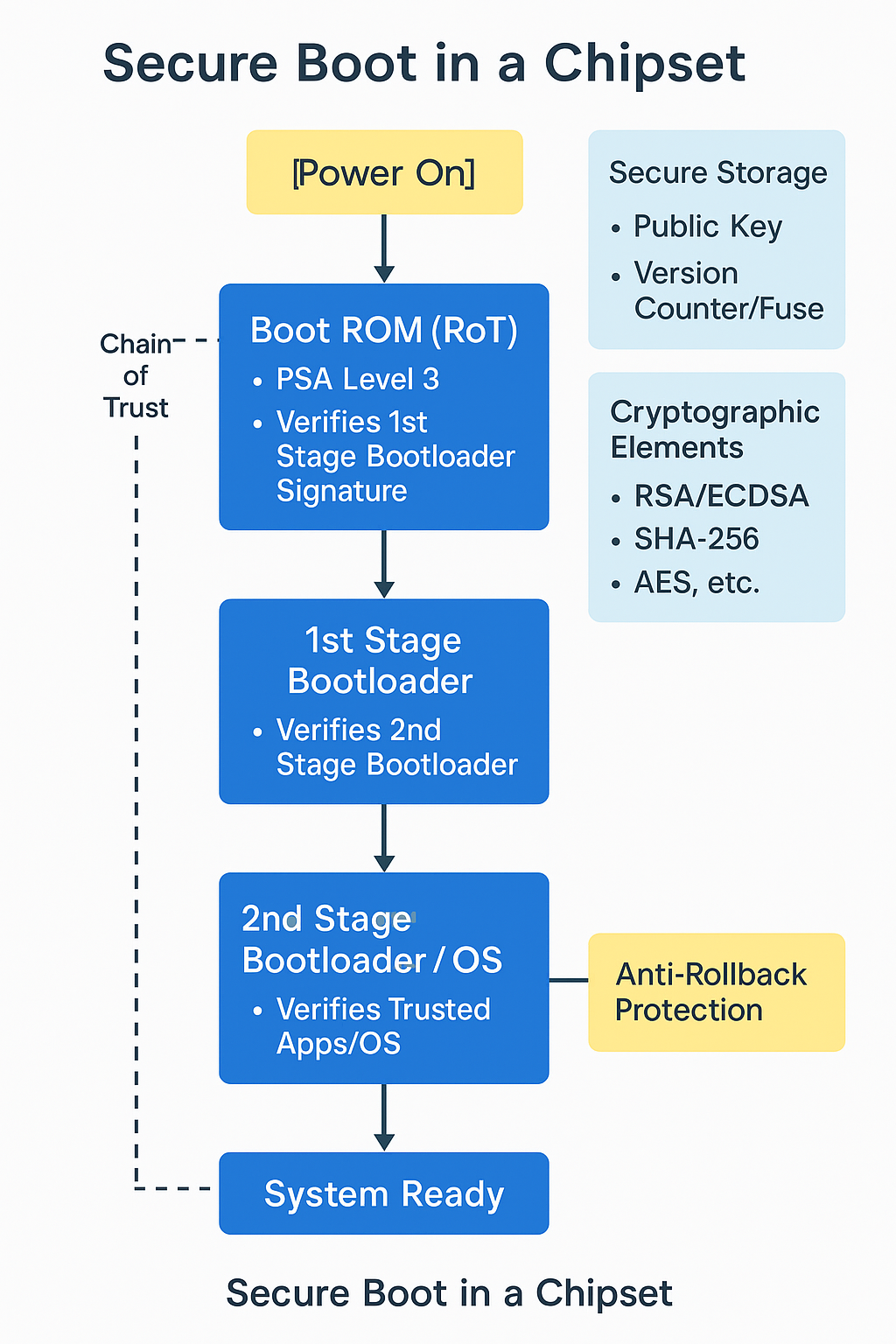Secure Boot in IoT Soc

One of the mandet from EU RED Cybersecurity Regulation is
Software update mechanisms: OTA (Over-the-Air) updates must be secure and verifiable.
Let see what is Secure Boot and how it will help us in achiving the same.
Secure Boot is a hardware-rooted security mechanism that ensures a device boots using only trusted firmware and software.
It prevents:
- Malware or unauthorized code from executing during boot.
- Rollback attacks by verifying firmware version integrity.
🧠 Secure Boot Architecture in a Chipset
- Root of Trust (RoT) Definition: Immutable code stored in ROM (Read-Only Memory) inside the chipset.
Purpose: Verifies the authenticity of the next boot stage.
Implemented As:
- Hardcoded bootloader hash or public key
- ROM-based signature validation logic
2. Boot ROM The first code executed on power-on.
Performs cryptographic validation (typically RSA/ECDSA) of:
- The first-stage bootloader
- Using digital signatures and a public key embedded in ROM
3. Chain of Trust
- Each boot stage cryptographically verifies the next:
- Boot ROM → 1st Stage Bootloader → 2nd Stage Bootloader → OS Kernel → Trusted App/OS
- If any step fails verification:
- Boot halts
- Optionally enters recovery mode
4. Cryptographic Elements
- Asymmetric crypto (RSA, ECDSA): for verifying signatures
- Symmetric crypto (AES, HMAC): for encrypting or authenticating firmware
- Hashing (SHA-256/512): to ensure data integrity
5. Anti-Rollback Protection
- Uses a monotonic counter or version fuse (eFuses or OTP memory)
- Prevents firmware downgrade attacks
6. Key Storage
- Public key: burned into ROM or eFuses
- Private key: securely held by the firmware signing authority (not on-chip)
7. Firmware Update Support
- Only signed updates are accepted
- Version check prevents downgrading
Some platforms support encrypted firmware as well
🔄 Secure Boot Flow Summary
-
Power On
↓
- Boot ROM (RoT)
- Verifies 1st Bootloader Signature
↓
- 1st Bootloader
- Verifies 2nd Bootloader
↓
- 2nd Bootloader / Kernel
- Verifies OS or Trusted Apps
↓
- System Ready
🔧 Example in Practice
For an IoT SoC (e.g.,NRF, NXP, STMicro, Qualcomm):
- Boot ROM is fixed in silicon.
- Secure Key Storage in eFuses or OTP memory.
- Bootloader uses X.509 certificates for chain-of-trust.
- Anti-rollback via version field in firmware and fuse-based version checks.
✅ Benefits
- Ensures system starts in a known-good state
- Protects against bootloader or firmware tampering
- Forms the foundation for Trusted Execution Environments (TEE) and Secure Firmware Updates
⚠️ Challenges
- Complex key management
- Device bricking if Secure Boot keys or policies are misconfigured
- Performance overhead during boot (mitigated with hardware acceleration)
🔒 Chipset Verification
Chipset secucity level can be validated at Platform Security Architecture PSA There are 3 Level of security
- Level 1: This is the foundational level, focusing on security best practices. It involves a questionnaire-based assessment to ensure compliance with baseline security requirements. It is ideal for demonstrating basic security measures
- Level 2: This level provides protection against scalable software attacks. It includes lab-based evaluations and vulnerability analysis to ensure the robustness of the device’s security features
- Level 3: The highest level, designed for devices requiring substantial assurance against both software and hardware attacks. It involves rigorous testing, including penetration tests and side-channel analysis, to verify the device’s resilience